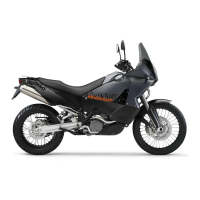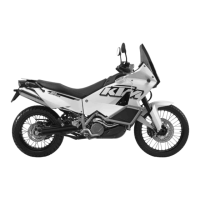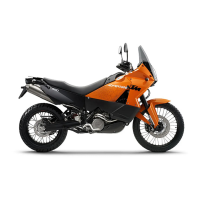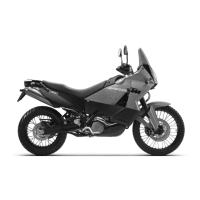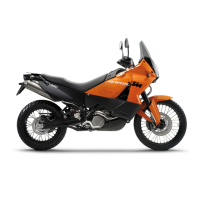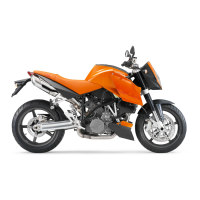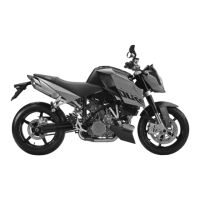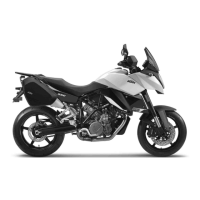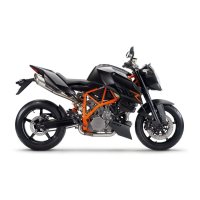Why is the combination instrument display blank on my KTM Motorcycle?
- MmatthewtranSep 12, 2025
If the combination instrument display is blank on your KTM Motorcycle, the ACC1, CLOCK fuse may be blown. Replace the fuse in the fuse box.
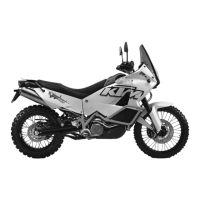
Why is the combination instrument display blank on my KTM Motorcycle?
If the combination instrument display is blank on your KTM Motorcycle, the ACC1, CLOCK fuse may be blown. Replace the fuse in the fuse box.
| Displacement | 999cc |
|---|---|
| Compression Ratio | 11.5:1 |
| Transmission | 6-speed |
| Front Tire | 90/90-21 |
| Rear Tire | 150/70-18 |
| Fuel Capacity | 19.5 liters |
| Bore x Stroke | 101 mm x 62.4 mm |
| Torque | 100 Nm |
| Starter | Electric |
| Cooling system | Liquid cooled |
| Front Suspension | WP USD 48 mm |
| Front Brake | 2 x 300mm discs |
| Rear Brake | 240mm disc |
Defines the intended use of KTM sport motorcycles for road and light offroad operation.
Emphasizes following safety instructions and locating warning labels on the vehicle.
Details different risk levels (Danger, Warning, Caution, Note) and their associated symbols.
Prohibits tampering with noise control systems and lists prohibited acts.
Details safety precautions for operating the vehicle, including alcohol/drug use and exhaust gas hazards.
Emphasizes the importance of wearing protective clothing for injury prevention.
Explains the function of the emergency OFF switch on the right handlebar for interrupting the ignition circuit.
Describes the ignition/steering lock location and its states (OFF, ON, locked).
Explains the electronic immobilizer's function and warning lamp indications.
Introduces the combination instrument and its four function areas.
Details the various indicator lamps on the instrument cluster and their meanings.
Provides crucial safety information for initial use, including rider impairment, protective clothing, and tire condition.
Details safety warnings and guidelines for loading the vehicle, including weight limits and handling characteristics.
Lists essential pre-trip checks for vehicle roadworthiness and proper functioning of all systems.
Provides instructions and safety precautions for starting the engine, including exhaust gases and battery conditions.
Covers shifting gears, riding techniques, and safety warnings related to load changes, downshifting, and adjustments.
Details braking system warnings and procedures, including efficiency due to wet conditions, spongy pressure, and failure.
Covers safety warnings for refueling (fire hazard, poisoning) and guidelines for fuel quality.
Explains how to check the hand brake lever's free travel and warns about potential brake failure.
Explains how to check brake disc thickness and wear limits, warning about reduced braking efficiency.
Details how to check the front brake fluid level and warns about system failure and efficiency reduction.
Explains how to check front brake lining thickness and wear, warning about reduced braking efficiency.
Explains how to check the rear brake fluid level and warns about system failure and efficiency reduction.
Explains how to check rear brake lining thickness and wear, warning about reduced braking efficiency.
Explains how to check the engine oil level using the dipstick, with safety warnings.
Outlines the procedure for changing engine oil and filter, including draining and cleaning oil screens.
Lists possible causes and actions for the engine not turning when the starter button is pressed.
Lists possible causes and actions for the engine having too little power.
Lists possible causes and actions when the engine overheats.
Lists possible causes and actions when the FI warning lamp is active.
Lists possible causes and actions for the engine dying during a trip.
Lists immobilizer blink codes (12-16) and their corresponding error level conditions.
Lists FI warning lamp blink codes (49, 50, 53, 54, 68) and their error conditions.
Provides detailed technical specifications for the motorcycle's engine, including displacement, bore, stroke, and valve data.
Lists engine components and their specified tightening torques, including thread locker recommendations.
Details the front and rear brake system specifications, including disc diameter and type.
